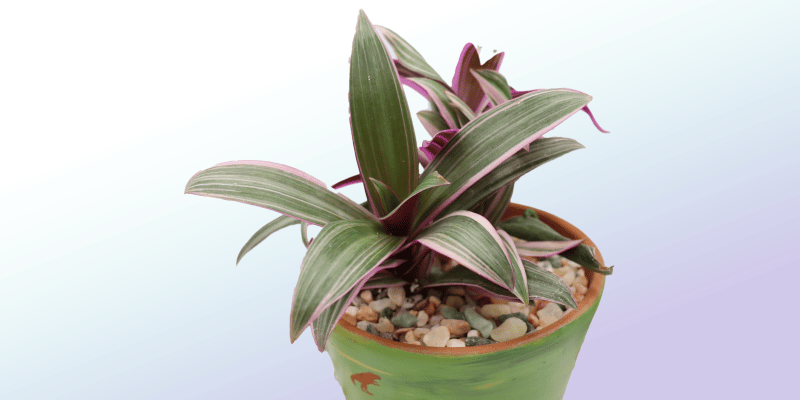Moses in the Cradle is a fast-growing plant from the tradescantia species, prized for its attractive foliage. Its vibrant purple, cream, pink, golden, or green leaves, depending on the variety, make for dazzling indoor plants, whether in a hanging basket or on your bookshelf.
We’ll clue you in on the many (many!) nicknames of the Moses plant, the most useful growing tips to keep its colors vibrant, and the easiest propagation methods.
Let’s get started!
Table of Contents
Moses in the Cradle Care Guide
History, Habitat, and Characteristics
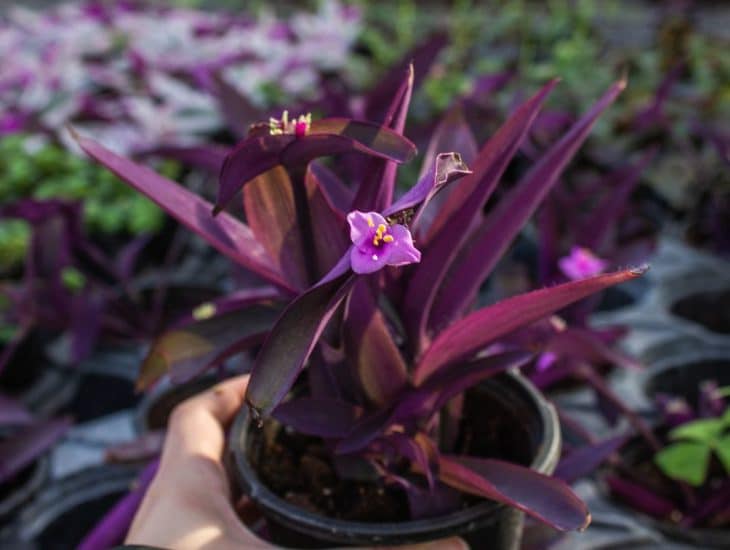
A perennial herb from the Commelinaceae family, Moses-in-the-Cradle (boat lily) gets its common name from its boat-shaped purple bracts (specialized leaves underneath flowers), which also look like cradles.
Ever since it was first written about by botanists in 1788, people can’t seem to definitively decide what vehicle Moses is in, but the plant also goes by Moses in the Bulrushes, Moses in a Basket, and — you guessed it — Moses in a Boat. Popular nicknames also include the cradle lily, boatlily, and oyster plant.
Moses-in-the-Cradle’s scientific name, Tradescantia spathacea, has royal origins. The first part, Tradescantia, is named for one of the gardeners of the English King Charles I, John Tradescant. Spathacea comes from the Greek word “spaqh,” which translates to “broad blade,” another reference to the leaves below its small white flowers. Moses-in-the-cradle used to be called Rhoeo spathacea, but you won’t see it referred to this way as often.
Native to temperate climates in Central America, specifically Guatemala, southern Mexico, and Belize, tradescantia spathacea plants are now grown widely in humid US climates like Texas, Florida, and Hawaii.
Cradle plants are one of 75 different types of indoor Tradescantia, or spiderwort, plants. They are semi-epiphytic, which means they can grow on the surface of another plant or object (epiphytic) or live independently.
The Moses plant features sword-shaped leaves that pack a two-fold color punch, with luscious dark green stripes on the top and a vibrant purple underside. They grow in a clumped rosette style, sporting flowers all through the year.
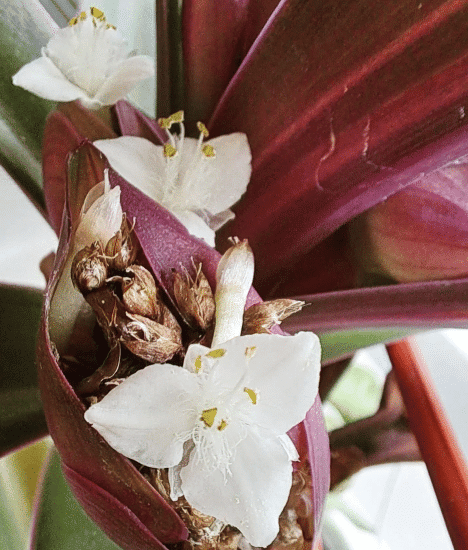
The flowers are thick and waxy, and you may have to look closely for them, as they can be hidden behind the cradle plant’s tall lance-shaped leaves. This plant’s stems resemble trunks, and they can also be almost entirely covered by its overlapping leaves.
Speaking of leaves, the cradle plant’s can grow anywhere from 6 to 12 inches long and up to three inches wide. When they grow, they emerge directly from the stem, and new leaves rise from the rosette center.
Let’s move on to lighting, water, and soil requirements for your plant!
Light
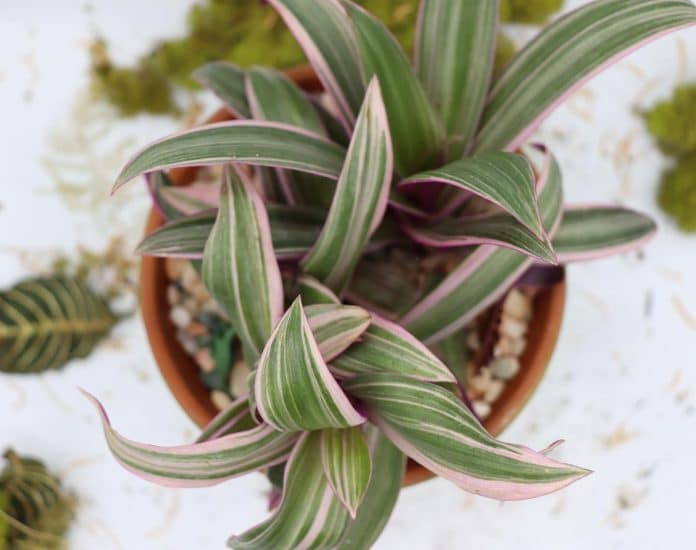
The oyster plant needs anywhere from six to eight hours of bright indirect light every day to bloom. It can still grow in low light, however — it just won’t produce flowers, and its usually purple undersides will retain more of a green hue. Since it also likes high humidity, if you’re more interested in its elegant leaves than flowers, the boat lily plant is perfect for a low-light bathroom environment.
Although the Moses plant requires very bright light, it doesn’t tolerate direct sunlight, which can burn its leaves. Place it close to an east or west-facing window for indirect bright light throughout the day.
If this isn’t possible, three to five feet away from a south-facing window, where light shines in directly but there is enough distance to prevent scorching, will also do the trick. You can also place it in a north-facing window for partial shade.
Water
How do you know when your tradescantia plants need water? Easy: stick a finger one to two inches deep into the soil. If it’s dry, time to get out your watering can. If the potting mix is wet, though, hold off on watering for a while.
Consider using a terracotta pot, which helps soak up water so it drains more quickly. While on the subject of your pot, make sure it has adequate drainage holes so water doesn’t pool at the bottom and cause root rot.
When you water Tradescantia spathacea, make sure you give it enough to soak the soil completely every time. This way, you give it more water less frequently, which is better for its health (and your schedule!).
I prefer rainwater (capturing it can be a fun adventure), distilled or filtered water as opposed to tap. This helps to prevent discolored foliage and stops harmful salts and minerals from building up in the soil.
Temperature and Humidity
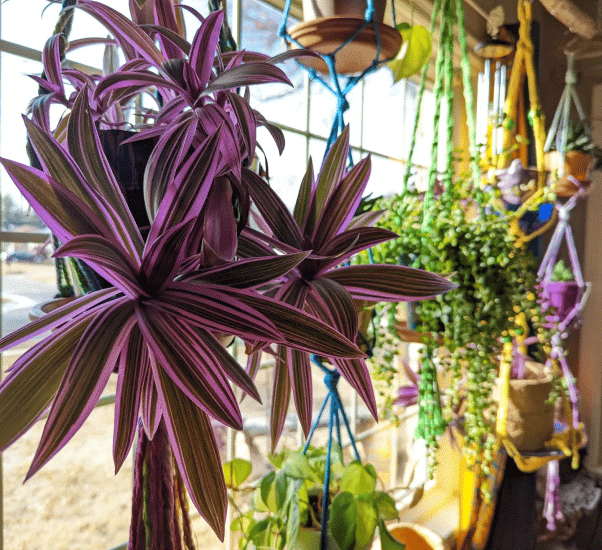
The boat lily enjoys the same household temperatures you probably do. While it can survive above 55 degrees, it prefers to be in an environment of anywhere from 65 to 80°F. The cradle plant thrives in USDA Zones 9-11.
The more humid your plant’s location, the greater the chance it will flower. While humidity levels of 60% to 70% and warm room temperatures encourage higher flowering rates, it may not be feasible or comfortable to keep your house at this level. Your Moses plant will do just fine in 40% humidity as well.
The best ways to increase the humidity around Moses-in-the-Basket include:
- Placing it close to a humidifier
- Misting it every two or three days
- Putting it on a tray with ornamental stones and water
- Positioning it near other plants so they can share humidity
Soil and Planting
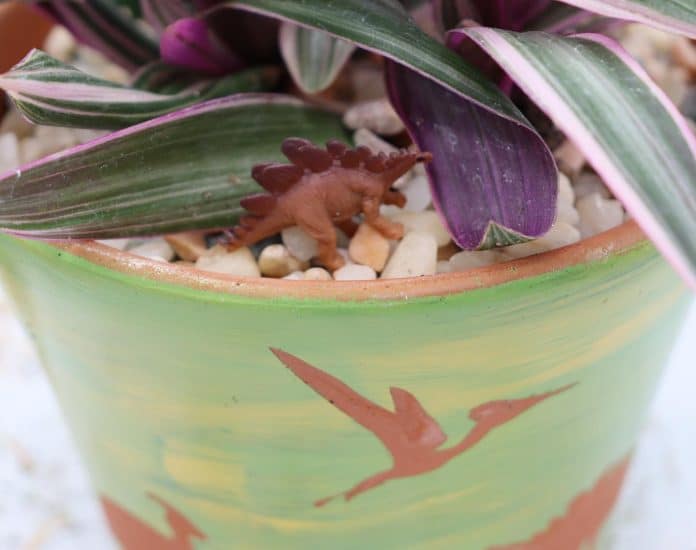
Moses in the Basket needs a well-draining, light soil mix that retains moisture but doesn’t remain soaked. To create the ideal potting soil ratio, you can use
- 33% potting soil
- 33% perlite
- 33% peat moss
This combination offers your plant enough nutrients for it to thrive without weighing the potting mix down. You can also use a combination of sand and organic matter like coco coir, bark mulch, compost, or even coffee grounds.
As long as water flows freely through and doesn’t pool at the top, the potting medium density is ideal.
Fertilizing
Tradescantia spathacea is a relatively fast-growing plant, so you’ll need to feed it once a month during the spring and summer months to maintain healthy growth. Use a water-soluble, balanced houseplant fertilizer at half-strength.
Be careful not to fertilize more than once a month or use a full-strength fertilizer when the plant is actively growing, as this can cause a harmful abundance of minerals to accumulate in the soil.
Since cradle plants are fast growers, you’ll have to repot every year or two to prevent them from becoming root-bound. Use a plant pot one size up from your plant’s existing pot each time.
Pruning
While you can prune your plant to make it bushier, you don’t have to. (As always, do cut off dead and dying leaves so your plant can focus its energy on the live ones). If you do choose to prune, pinch off the tips of growing leaves to encourage outward instead of upward growth.
Be careful not to take off more than 10% of the plant at a time to ensure it stays healthy.
Now that you know how to keep your cradle plant thriving with the right light, temperature, and soil, let’s find out how to propagate it and make more!
Propagation Guide
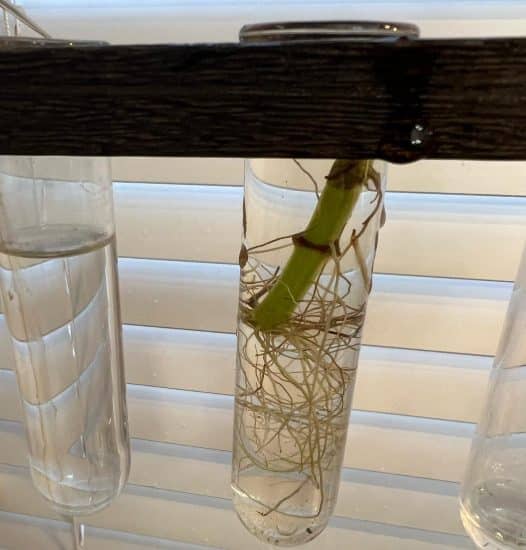
You can propagate Moses in the Cradle by root division, stem cuttings, or even seed. When your plant’s flowers dry out, you can plant the tiny seeds that form inside.
For those without dried flowers, I personally find the root division approach the easiest, but the stem-cutting method is also quick and simple. Make sure to wear gloves when handling your plant to avoid skin irritation.
To propagate your cradle plant by root division:
- Remove the root ball from its pot and gently brush or wash away any attached soil.
- Carefully untangle and remove any small new growth (or pups) you see sprouting around the edges.
- Place the pups in their own pots and make sure to water them thoroughly.
Hot tip: You can propagate by root division while you’re repotting to save time—two tasks in one!
To propagate by stem cuttings:
- Snip a stem section of 4 to 6 inches with several leaves attached.
- Trim off the very bottom leaves and cut right below the lowest node (a small bump where new growth emerges).
- Put the prepared stem in a water jar or moistened soil.
- Make sure the stem is in a humid, warm environment. You should see roots form within 4 weeks. Once you do, put the new plantlings in their own pots. And that’s it!
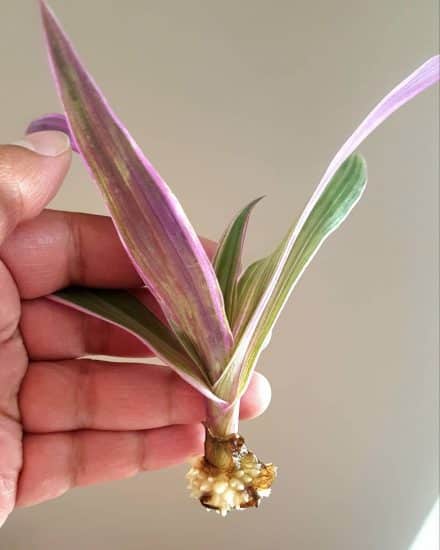
Common Issues
Brown leaf tips. If your cradle plant’s leaf tips are browning, the air around it is too dry. Try to place it in an environment with more humidity or artificially create some.
Drooping leaves. Is your cradle plant yellow and drooping? You’re overwatering it. Is it brown and drooping? You’re not giving it enough water.
Green leaf undersides. You can have a healthy plant with a green underbelly, but if you miss the intense purple underside the moses plant is known for, place it in a location with more light (but never full sun!).
Faded leaf colors. If your Tradescantia spathacea plant is getting either too little or too much light, its vibrant green and purple leaves can fade. Too much sunlight can also cause stunted growth. Is your plant in direct sunlight? Move it to a shadier spot.
Diseases and Pests
Moses plants can suffer from root rot and pests like mealybugs, spider mites, and others. Luckily, avoiding or addressing these problems isn’t difficult.
Root Rot
The most common reason for dead or decaying roots is root rot. This can occur when your cradle plant is overwatered or has soil that is too dense to drain properly. Telltale signs of root rot include overall stunted growth, leaves that turn yellow very quickly, and mushy or collapsing stems.
If you suspect your plant’s roots are rotting, swap out its soil mix for a lighter one that contains more organic matter as soon as possible. Also, ensure the pot you choose has an adequately sized drainage hole.
Mealybugs and Other Pests
Moses in the Cradle can become infested with the usual pesky mealy bugs, spider mites, aphids, and scale. To defeat them without using pesticide, which can harm your plant, use a mix of one tablespoon of liquid castile soap in one gallon of water. Pour the mixture into a spray bottle, shake well, and spray all your plant leaf tops and undersides. Do this once a week until the problem is resolved.
It’s also a good idea to isolate the affected plant as soon as you notice an issue so critters don’t hop to other plants in your collection.
Conclusion
The Moses in the Cradle plant is one of the most vibrant indoor plants, with plenty of glorious cultivar hues to go around. It can’t tolerate direct sun or overly dry air, however, so make sure to keep it in a place where it can get plenty of indirect bright light and high humidity. Home your plant in a light potting mix to ensure easy drainage.
While its namesake cradle-shaped bracts can support small white flowers in optimal growing conditions, this plant can also lead a perfectly healthy life with less sunlight. Propagate it via seed, stem, or root division to keep your collection robust enough to share with friends!
Do you have any great care tips we missed? If you have any suggestions or questions, feel free to reach out to us on Instagram or Twitter!
FAQ
Are there varieties of Moses in a Cradle?
While the most common variety of this plant type is striped green on top and purple underneath, there are two notable cultivars:
Tradescantia spathacea Sitara’s Gold. Sitara’s Gold, also known as the Golden Oyster or Vittata, has bright yellow and green striped leaves.
Tradescantia spathacea tricolor. The Tricolor or Variegata, sometimes called the Rhoeo discolor Variegata, is a newer cultivar with a mix of vibrant cream, green, and pink leaves.
Is Moses in a Cradle an indoor plant?
While Moses in a boat can be grown both inside and out, either way, it’s best kept as a container plant because it can become invasive otherwise.
How do I make my Moses in a Cradle look bushy?
If your cradle plant is looking leggy, trim off dead foliage from bottom leaves to encourage more growth. You can also chop off healthy four to six-inch stem sections and replant the cuttings back into the same plant pot.

